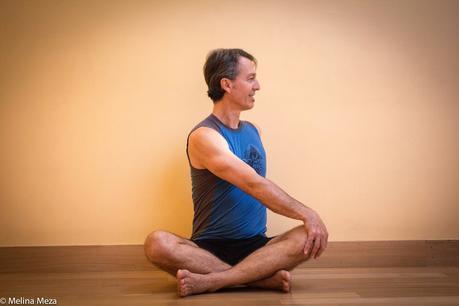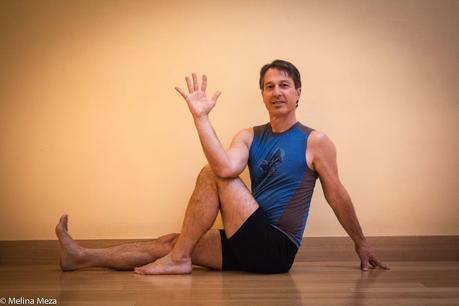 Q: You have written superbly about the spine but I can't find any comments on maintaining an upright spine for seated twists. Please, could you explain the anatomical need for this sometime?
Q: You have written superbly about the spine but I can't find any comments on maintaining an upright spine for seated twists. Please, could you explain the anatomical need for this sometime?A: The first thing to ask is: is it actually important to maintain an upright spine when doing seated twists? To this, I would say “yes,” for both immediate success in having the greatest rotating range of motion in your twist and, secondarily, for the long-term health of your spine. You might try a little experiment right now. Sitting in your chair or on the floor in simple Crossed-Legs pose (Sukasana), allow your spine to slump forward into a “C” shape. Try to twist to your right and notice how far your twist gets. Then come back to center, maintain your slouchy position, and repeat to the left, noting again how far you are able to twist. Next, coming back to center, lengthen up from your sitting bones to the crown of your head, establishing what I like to call the “inner lift” of your spine. I also call it the “prime directive” (for all you Trekkies, this is a bit different than the guiding principle Jean Luc Piccard was constantly invoking!), as I feel it keeps your spine ready and safer to move into any yoga pose direction. Now repeat your twist experiment and notice your range of motion: 99% of you will find you can twist a little or a lot further with a lifted spine.
Sukasana Twist
I just tried the same experiment with my spine lifted into a bit of a back bend, and, for my body, the back bend arch also limited my twisting ability compared to the neutral lifted posture. So, there is practical value in sitting upright for seated twists; you can increase your range of motion, which could come in handy in daily life, like turning to check on this kids or grandkids who are sitting in the back seat of the car!Yes, you can twist while forward bending (we do this in some asymmetrical forward bends, such as Janu Sirsasana and Parsvottanasana), and you can twist while back bending (we do this a bit in certain asymmetrical backbends, such as Natarajasana). But the spine rotates maximally from its neutral alignment. Creating your inner lift, or what Leslie Kaminoff refers to as Axial Extension, allows you to start any seated twist with the most overall length in the spine.
If we could look at the cushiony discs between each vertebrae of the spine while we twist, we could see that the disc compresses down a bit and loses some height in the twist, and then after the twist, usually springs back up to full thickness. And if you add up all the discs in an entire spine (23, as the top two spaces don’t have a disc proper), the cumulative result of going into a deep seated twist is the loss of some overall height, until you come out of the twist. The squeezing and pumping action on the discs though all directions of movement, if fairly evenly done (meaning not overdoing just one movement, for example, forward bending) will tend to keep the discs healthy over time. Inevitably, over time, the discs and bones of the spine will gradually change by losing water content, becoming a bit less resilient, and experiencing wear and tear. That’s right, more of that aging process! But maintaining good posture, especially in seated twists, as well as any twists, distributes the forces in the discs in a more even and, hopefully, healthier way than, say, always being in a bit of forward bend (like a couple of my students who are professional gardeners) or a bit a backbend (like my contractor who painted the ceilings in my house one time). These folks may be at risk of spinal problems down the road. But their yoga practice could act as an antidote to some of those repetitive directions of movement their jobs require!It might also be helpful to think about where you are turning from when you twist. It turns out the spinal areas have different abilities to twist easily. For instance, the lumbar spine can only allow about 5 degrees of rotation, which is not very much. In fact, the lumbar spine tends to go where the sacrum turns because of that. If you keep your sacrum facing forward in Sukasana and turn everything above, the spine itself does not start rotating naturally into the twist until you get to the area of L1, T12 and T11. If, however, you try to force the lower lumbar area to turn independently of the pelvis and sacrum, you run the risk of overstretching the supportive ligaments that run from the lower lumbar bones to the pelvis bones, which is destabilizing for the spine, and can possibly cause the sacro-iliac joint on one side to overstretch, which is destabilizing for the SI joint. So, some prominent teachers encourage you to allow your sacrum and pelvis to rotate in the direction of the twist, while others suggest you focus on the twist coming from the L1, T12, T11 interchange. I usually fall in the later camp, recommending that my students start twisting from the navel area, but understand that the twist will “look” like a bigger twist if you start with the pelvic area. I suggest you play around with the easier seated twists, such as Sukasana, Marichyasana 3, and Upavista Konasana twists.Marichyasana 3
First try turning from your pelvis. Then try turning from around the area of the navel line (an imaginary line I envision around the equator of my belly at the navel that corresponds to L1, T12, T11). See what you discover about the degree of satisfaction you get from each one!What about the other areas of the spine? What is their capacity to rotate? The thoracic spine is capable of 35 degrees of rotation, and the cervical spine has the most ability to rotate, allowing up to 50 degrees of rotation. Due to the greater twisting ability of the neck area, practitioners often tend to lead with this area in twists. I like to have you start from the navel area to get a better sense of what the middle spine can do before adding in the ease of the neck turn. (I don’t always start from down low, but do a good 95% of the time!)
—BaxterSubscribe to Yoga for Healthy Aging by Email ° Follow Yoga for Healthy Aging on Facebook ° Join this site with Google Friend Connect


